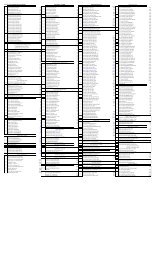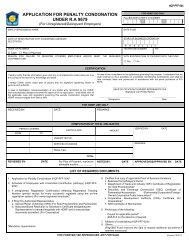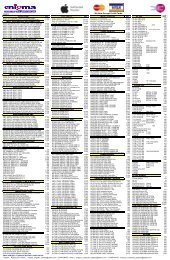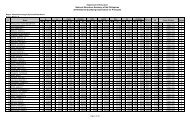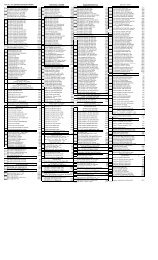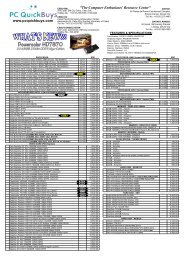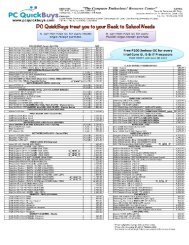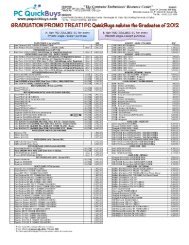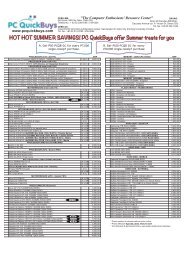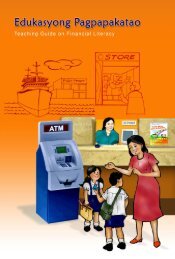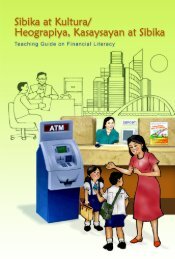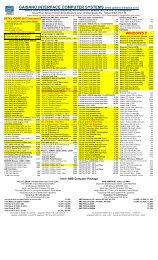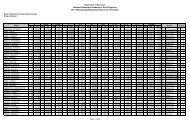Ideas for Using Hex-a-flex Blocks to Teach ... - AffordableCebu
Ideas for Using Hex-a-flex Blocks to Teach ... - AffordableCebu
Ideas for Using Hex-a-flex Blocks to Teach ... - AffordableCebu
- No tags were found...
Create successful ePaper yourself
Turn your PDF publications into a flip-book with our unique Google optimized e-Paper software.
An In-Service Training (INSET) Package in Elementary Mathematics<br />
<strong>Ideas</strong> <strong>for</strong> <strong>Using</strong> <strong>Hex</strong>-a-<strong>flex</strong><br />
<strong>Blocks</strong> <strong>to</strong> <strong>Teach</strong><br />
Mathematics<br />
Facilita<strong>to</strong>r’s Guide<br />
Presentation Plan<br />
Master Set of Resources<br />
Reprinted<br />
by the Philippines - Australia Hastening the Impact of PROBE (HIP)<br />
under the AusAID Vulnerable Groups Facility (VGF)<br />
Revised<br />
by the Learning Resource Management and Development System (LRMDS) Region VII<br />
under the Strengthening the Implementation of Basic Education in Selected Provinces in the Visayas<br />
(STRIVE)<br />
Philippine-Australia Project in Basic Education (PA-PROBE)<br />
Regional Learning Materials Center (RLMC VII)
Published by the<br />
PHILIPPINES - AUSTRALIA PROJECT IN BASIC EDUCATION (PROBE)<br />
REGIONAL LEARNING MATERIALS CENTER VII (RLMC VII)<br />
Department of Education, Culture and Sports<br />
Region VII, Central Visayas<br />
Cebu City<br />
Copyright © 1999 by PROBE<br />
Reprint Edition 2002<br />
Revised Edition 2010<br />
COPYRIGHT NOTICE<br />
Section 9 of Presidential Decree No. 49 provides:<br />
“No copyright shall subsist in any work of the Government of the Republic of the<br />
Philippines. However, prior approval of the government agency of office wherein the<br />
work is created shall be necessary <strong>for</strong> exploitation of such work <strong>for</strong> profit.”<br />
This material has been developed within the Project in Basic Education (PROBE)<br />
implemented by the Educational Development Projects Implementing Task Force<br />
(EDPITAF) of the Department of Education (DepEd) in collaboration with the Bureau of<br />
Elementary Education, Bureau of Secondary Education and the Commission on Higher<br />
Education. Prior approval must be given by the PROBE Management Unit lodged at<br />
EDPITAF and the source must be clearly acknowledged.<br />
MISS DEBRA K. MARTIN<br />
RLTA RLMC - VII<br />
Writer<br />
This INSET package has been edited and produced by the PA - PROBE RLMC VII staff.<br />
This edition has been revised <strong>for</strong> online distribution through the Learning Resource<br />
Management Development System (LRMDS) Portal by Region VII-Bohol under Project<br />
STRIVE <strong>for</strong> BESRA, a project supported by AusAID.
INSET PACKAGE<br />
<strong>Ideas</strong> <strong>for</strong> <strong>Using</strong> <strong>Hex</strong>-a-<strong>flex</strong><br />
<strong>Blocks</strong> <strong>to</strong> <strong>Teach</strong> Mathematics<br />
3. Master Set of Resources
INSET PACKAGE: <strong>Ideas</strong> <strong>for</strong> <strong>Using</strong> <strong>Hex</strong>-a-<strong>flex</strong> blocks <strong>to</strong> <strong>Teach</strong> Mathematics<br />
<strong>Using</strong> <strong>Hex</strong>-a-<strong>flex</strong> <strong>Blocks</strong> <strong>to</strong> Explore<br />
Geometric and Fraction Concepts<br />
1 FACILITATOR’S GUIDE<br />
Description<br />
In this workshop participants will be shown different ways of using <strong>Hex</strong>-a-<strong>flex</strong><br />
blocks <strong>to</strong> explore fractions and geometric concepts. Participants will be involved in<br />
experiencing a range of hands-on activities. Time will be provided <strong>for</strong> participants<br />
<strong>to</strong> collaboratively create a hex-a-<strong>flex</strong> activity <strong>to</strong> be trialled in their classrooms.<br />
Note: This workshop is <strong>to</strong> be presented after participants have completed the INSET “Learning<br />
Math by Doing.”<br />
Rationale<br />
Many pupils experience difficulty in developing an understanding of fractions.<br />
It is well documented that the use of concrete materials can assist pupils <strong>to</strong> grasp<br />
an understanding of basic fraction concepts and the relationship among them. To<br />
enable teachers <strong>to</strong> provide students with more concrete learning experiences sets<br />
of hex-a-<strong>flex</strong> blocks have been given <strong>to</strong> all the PROBE elementary schools. This<br />
workshop will provide participants with sample activities that can be used <strong>to</strong> explore<br />
fractions and geometric concepts.<br />
Target Audience<br />
Grades V – VI Math teachers<br />
Duration<br />
2 hours<br />
Objectives<br />
Participants will:<br />
• use hex-a-<strong>flex</strong> blocks <strong>to</strong> solve math activities<br />
• create and document a math activity that involves the use of the<br />
hex-a- <strong>flex</strong> blocks<br />
• evaluate a range of activities<br />
• identify benefits of using hex-a-<strong>flex</strong> blocks <strong>to</strong> develop fraction and<br />
geometrical concepts.<br />
Preparation<br />
1
INSET PACKAGE: <strong>Ideas</strong> <strong>for</strong> <strong>Using</strong> <strong>Hex</strong>-a-<strong>flex</strong> blocks <strong>to</strong> <strong>Teach</strong> Mathematics<br />
• Prior <strong>to</strong> the workshop the facilita<strong>to</strong>r will need <strong>to</strong> prepare at least five<br />
fraction models (see Activity Card 1: Exploring Fractions) <strong>for</strong><br />
Exploring Fraction Activity 1.<br />
• Participants should be asked <strong>to</strong> bring the math text books and a copy of<br />
the math competencies <strong>for</strong> grades 5 and 6.<br />
Evaluation<br />
The success of the workshop will be measured by appraising the participants’ ability <strong>to</strong>:<br />
• complete the activities<br />
• participate in discussions about the activities<br />
• ability <strong>to</strong> identify and discuss the benefits of using hex-a-<strong>flex</strong> blocks <strong>to</strong><br />
develop fraction and spatial concepts<br />
• create a math activity either individually or in a small group<br />
• list the benefits of using hex-a-<strong>flex</strong> blocks <strong>to</strong> develop fraction and spatial<br />
concepts.<br />
Resource List<br />
Activity Cards<br />
Exploring Geometric Shapes Activity Card 1:<br />
Exploring Geometric Shapes Activity Card 2:<br />
Exploring Geometric Shapes Activity Card 3:<br />
Exploring Fractions Activity Card 1:<br />
Exploring Fractions Activity Card 2:<br />
Exploring Fractions Activity Card 3:<br />
Build the Shape<br />
Shape Puzzle<br />
Block Challenge<br />
Fraction Models<br />
Read, Make and Solve<br />
Fraction Puzzles<br />
Handouts<br />
Handout 1:<br />
Handout 2:<br />
Solutions <strong>to</strong> Rotational Activities<br />
Design a Math Activity<br />
Equipment<br />
1 set of <strong>Hex</strong>-a-<strong>flex</strong> blocks <strong>for</strong> each group of 6 participants<br />
2
INSET PACKAGE: <strong>Ideas</strong> <strong>for</strong> <strong>Using</strong> <strong>Hex</strong>-a-<strong>flex</strong> blocks <strong>to</strong> <strong>Teach</strong> Mathematics<br />
2 PRESENTATION PLAN FOR FACILITATOR<br />
Session Time Activity Comment<br />
1 10 min Introduc<strong>to</strong>ry Activity: Memory<br />
Game<br />
• Organize participants<br />
in<strong>to</strong> groups of 2 - 4<br />
members.<br />
• Each participant selects<br />
2 of each of the blue,<br />
yellow, orange and<br />
green hex-a-<strong>flex</strong><br />
blocks.<br />
• Tell participants they will<br />
be:<br />
(i) shown a 3 dimensional<br />
(3-D) shape<br />
that has been built<br />
using the same<br />
color and number<br />
of cubes that they<br />
have<br />
(ii) given 30 seconds <strong>to</strong><br />
study the shape,<br />
be<strong>for</strong>e it will be<br />
covered<br />
(iii) asked <strong>to</strong> build the<br />
shape they were<br />
shown from memory.<br />
• Allow approximately 3<br />
minutes <strong>for</strong> participants<br />
<strong>to</strong> complete the activity.<br />
• Invite one participant<br />
<strong>to</strong> display his/her<br />
group’s construction.<br />
Ask: “How is this<br />
construction<br />
different <strong>to</strong>/the same as<br />
the original”<br />
• Facilita<strong>to</strong>r displays the<br />
original shape. Participants<br />
compare the 2<br />
shapes. Invite participants<br />
<strong>to</strong> use mathematical<br />
language <strong>to</strong> describe<br />
how their shape is<br />
different from the original<br />
• Prior <strong>to</strong> starting the<br />
workshop the facilita<strong>to</strong>r<br />
needs <strong>to</strong> construct a 3<br />
dimensional shape<br />
using 2 each of the<br />
blue, yellow, orange<br />
and green hex-a-<strong>flex</strong><br />
blocks. Make certain<br />
that the participants<br />
prior <strong>to</strong> doing the introduc<strong>to</strong>ry<br />
activity cannot<br />
see this shape.<br />
• Encourage participants<br />
<strong>to</strong> note the color and<br />
the position of each<br />
block.<br />
• Encourage participants<br />
<strong>to</strong> work independently.<br />
• Encourage participants<br />
<strong>to</strong> note differences<br />
other than the color of<br />
the blocks used.<br />
• Possible responses <strong>to</strong>:<br />
(b) Mathematical<br />
language such as<br />
faces, edge etc.<br />
• Point out that this is one<br />
way of introducing the<br />
blocks <strong>to</strong> pupils and<br />
getting them used <strong>to</strong><br />
manipulating them.<br />
1
INSET PACKAGE: <strong>Ideas</strong> <strong>for</strong> <strong>Using</strong> <strong>Hex</strong>-a-<strong>flex</strong> blocks <strong>to</strong> <strong>Teach</strong> Mathematics<br />
Session Time Activity Comment<br />
• Ask participants:<br />
(a) How did you feel about<br />
this activity Why<br />
(b) What mathematics<br />
did you use when<br />
doing this activity<br />
2<br />
5 min<br />
Workshop Overview<br />
• Facilita<strong>to</strong>r explains that the<br />
workshop focuses on<br />
using the <strong>Hex</strong>-a-<strong>flex</strong> blocks<br />
<strong>to</strong> explore fractions and<br />
geometric concepts.<br />
Participants will:<br />
1. use hex-a-<strong>flex</strong> blocks <strong>to</strong><br />
solve math activities<br />
2. identify benefits of<br />
using hex-a-<strong>flex</strong> blocks<br />
<strong>to</strong> develop fraction and<br />
geometric concepts<br />
3. design a math activity<br />
that involves the use<br />
of the <strong>Hex</strong>-a-<strong>flex</strong><br />
blocks.<br />
• Remind participants<br />
that all elementary<br />
PROBE schools<br />
have been given sets of<br />
the hex-a-<strong>flex</strong> blocks.<br />
• Mention that other math<br />
concepts can be developed<br />
with the hex-a<strong>flex</strong><br />
blocks, however<br />
this workshop will only<br />
focus on fraction and<br />
geometric concepts.<br />
3<br />
70 min<br />
Rotational Activities<br />
• Organize participants in<strong>to</strong><br />
groups with 2-4 members.<br />
• Explain the procedures<br />
1. Assign each group <strong>to</strong> an<br />
activity station. Six<br />
be<br />
different<br />
presented.<br />
Exploring Geometric<br />
Shapes<br />
Activity Card 1:<br />
activities will<br />
Build<br />
the<br />
shape<br />
Activity Card 2: Shape<br />
Activity Card 3:<br />
Puzzle<br />
Block<br />
Challenge<br />
• Multiple copies of<br />
each activity will need<br />
<strong>to</strong> be available and set<br />
up as a learning<br />
station prior <strong>to</strong><br />
commencing the rotational<br />
activities.<br />
• Refer <strong>to</strong> Handout 1<br />
solutions <strong>for</strong> Fraction<br />
Models, <strong>to</strong> make<br />
models <strong>for</strong> Exploring<br />
Fractions activity card<br />
1. Use 2 different<br />
colours <strong>to</strong> represent<br />
each model.<br />
2
INSET PACKAGE: <strong>Ideas</strong> <strong>for</strong> <strong>Using</strong> <strong>Hex</strong>-a-<strong>flex</strong> blocks <strong>to</strong> <strong>Teach</strong> Mathematics<br />
Session Time Activity Comment<br />
Exploring Fractions<br />
Activity Card 1: Fraction<br />
Models<br />
Activity Card 2: Read,<br />
Make<br />
and<br />
Solve<br />
Activity Card 3:<br />
Fraction<br />
Puzzles<br />
2. Ten minutes will be<br />
allowed <strong>for</strong> each<br />
activity.<br />
3. Upon signal, groups<br />
rotate in a clockwise<br />
direction <strong>to</strong> next activity.<br />
• Participants do the activities.<br />
• Group discussion. Refer <strong>to</strong><br />
each activity and ask<br />
participants <strong>to</strong> share solutions<br />
and the methods<br />
used. Ask participants if<br />
they would use these kinds<br />
of activities in the class-<br />
• Move around the<br />
groups, checking<br />
progress.<br />
• Refer <strong>to</strong> Handout 1 <strong>for</strong><br />
Solutions.<br />
• Point out that the<br />
activities are similar <strong>to</strong><br />
those in the textbook<br />
“Mathematics in<br />
Everday Life” <strong>for</strong> grade<br />
5 pupils.<br />
4 30 min Designing an Activity<br />
• Arrange participants in<strong>to</strong><br />
groups of 2 <strong>to</strong> 3. Task is <strong>to</strong><br />
design a new activity or<br />
modify one of the <strong>Hex</strong>-a-<strong>flex</strong><br />
activities used in the session<br />
<strong>to</strong> introduce, develop or<br />
extend geometric or<br />
fraction concepts.<br />
• Provide each group with a<br />
copy of Handout 2 <strong>for</strong><br />
recording the activity.<br />
• Discuss what needs <strong>to</strong> be<br />
recorded under each<br />
heading.<br />
• Allow 15 minutes <strong>for</strong> designing<br />
the activity.<br />
• Move around the<br />
groups, checking<br />
progress.<br />
3
INSET PACKAGE: <strong>Ideas</strong> <strong>for</strong> <strong>Using</strong> <strong>Hex</strong>-a-<strong>flex</strong> blocks <strong>to</strong> <strong>Teach</strong> Mathematics<br />
Session Time Activity Comment<br />
• Each group exchanges their<br />
activity with another group.<br />
• Allow 10 minutes <strong>for</strong> participants<br />
try the activity<br />
written by another group.<br />
Description of Activity<br />
• Each group shares the<br />
activity and comments on:<br />
(a) The main benefit of the<br />
activity.<br />
(b) The main weakness of<br />
the activity.<br />
• Facilita<strong>to</strong>r collects all the<br />
completed sheets.<br />
5 min<br />
Reflection<br />
• Invite participants <strong>to</strong> respond<br />
orally <strong>to</strong> the following:<br />
(i) What did you gain from<br />
this workshop<br />
(ii) Identify the benefits of<br />
using <strong>Hex</strong>-a-<strong>flex</strong> blocks<br />
<strong>to</strong> teach fraction and<br />
geometrical concepts.<br />
• Give each participant a copy<br />
of the activity cards and<br />
Handout 1.<br />
• Encourage participants<br />
<strong>to</strong> trial the activity<br />
designed in their classroom,<br />
make any<br />
necessary changes and<br />
return it <strong>to</strong> the facilita<strong>to</strong>r.<br />
Facilita<strong>to</strong>r <strong>to</strong> compile a<br />
booklet containing the<br />
activities created.<br />
4
INSET PACKAGE: <strong>Ideas</strong> <strong>for</strong> <strong>Using</strong> <strong>Hex</strong>-a-<strong>flex</strong> blocks <strong>to</strong> <strong>Teach</strong> Mathematics<br />
Activity Card 1: Exploring Geometric Shapes<br />
Build the Shape<br />
Instructions<br />
• Use the <strong>Hex</strong>-a-<strong>flex</strong> blocks <strong>to</strong> build the shape<br />
described.<br />
• Check and record your answer.<br />
Clues<br />
1. It is a closed spatial figure.<br />
2. It has six faces.<br />
3. All its edges are congruent.<br />
4. All of its faces are congruent.<br />
Extension Activity<br />
Writing Clues<br />
1. Use the <strong>Hex</strong>-a-<strong>flex</strong> blocks <strong>to</strong> construct a 3<br />
dimensional shape.<br />
2. Write a set of clues <strong>for</strong> someone else <strong>to</strong><br />
follow <strong>to</strong> build the shape you constructed.<br />
3. Check that the clues are accurate and can<br />
be easily followed.
INSET PACKAGE: <strong>Ideas</strong> <strong>for</strong> <strong>Using</strong> <strong>Hex</strong>-a-<strong>flex</strong> blocks <strong>to</strong> <strong>Teach</strong> Mathematics<br />
Activity Card 2: Exploring Geometric Shapes<br />
Shape Puzzle<br />
Instructions<br />
• Use the <strong>Hex</strong>-a-<strong>flex</strong> blocks <strong>to</strong> build the threedimensional<br />
shape described by the clues.<br />
• Check and record your answer.<br />
Clues<br />
1. It is a closed spatial figure.<br />
2. It has six faces.<br />
3. Opposite faces are congruent.<br />
4. Four of the six faces are rectangular.<br />
Extension Activity<br />
Write 2 <strong>to</strong> 4 sentences describing the mathematical<br />
properties of the three-dimensional<br />
shape you constructed.
INSET PACKAGE: <strong>Ideas</strong> <strong>for</strong> <strong>Using</strong> <strong>Hex</strong>-a-<strong>flex</strong> blocks <strong>to</strong> <strong>Teach</strong> Mathematics<br />
Activity Card 3: Exploring Geometric Shapes<br />
Block Challenge<br />
Instructions<br />
• Use the <strong>Hex</strong>-a-<strong>flex</strong> blocks <strong>to</strong> build the<br />
shape described by the clues.<br />
• Check and record your answer.<br />
Clues<br />
1. There are six blocks in all.<br />
2. One of the blocks is white.<br />
3. The purple block shares one face with each of<br />
the other five blocks.<br />
4. The two green blocks do not <strong>to</strong>uch each other.<br />
5. The two orange blocks do not <strong>to</strong>uch each other.<br />
6. Each green block shares an edge with the white<br />
block.<br />
7. Each orange block shares one edge with each<br />
of the green blocks.
INSET PACKAGE: <strong>Ideas</strong> <strong>for</strong> <strong>Using</strong> <strong>Hex</strong>-a-<strong>flex</strong> blocks <strong>to</strong> <strong>Teach</strong> Mathematics<br />
Activity Card 1: Exploring Fractions<br />
Fraction Models<br />
Instructions<br />
Study the fraction models displayed and name<br />
each fraction. If the model shows an improper<br />
fraction, give its mixed number <strong>for</strong>m.<br />
For example:<br />
Given:<br />
The illustration shows 10/7 which is an improper fraction.<br />
Participants will then express 10/7 in mixed number <strong>for</strong>m.<br />
the answer is 1 3/7.<br />
So<br />
2. On a sheet of paper write the letter identifying<br />
each model, then beside the letter record your<br />
answer.
INSET PACKAGE: <strong>Ideas</strong> <strong>for</strong> <strong>Using</strong> <strong>Hex</strong>-a-<strong>flex</strong> blocks <strong>to</strong> <strong>Teach</strong> Mathematics<br />
Activity 2: Exploring Fractions<br />
Read, Make and Solve<br />
Instructions<br />
• Use the <strong>Hex</strong>-a-<strong>flex</strong> blocks <strong>to</strong> make a fraction<br />
model <strong>to</strong> find the answer <strong>to</strong> the following<br />
problems.<br />
• Beside the number of the problem draw the<br />
model you made and write your answer.<br />
Problems<br />
1. In a family of 6 children, one is a boy. What part<br />
of the group is the boy<br />
2. Mrs Banzon baked a bar cake <strong>for</strong> her children.<br />
She divided it in<strong>to</strong> 12 equal parts. Her children<br />
5/12. How much was left<br />
3. A group of 3 girls made leche flan in their cooking<br />
class. It was divided in<strong>to</strong> equal parts. After<br />
tasting 1/7 they shared the remaining leche flan<br />
equally. What fraction of the whole flan did each<br />
girl get<br />
ate<br />
Extension Activity: Create your own word problem.
INSET PACKAGE: <strong>Ideas</strong> <strong>for</strong> <strong>Using</strong> <strong>Hex</strong>-a-<strong>flex</strong> blocks <strong>to</strong> <strong>Teach</strong> Mathematics<br />
Activity 3: Exploring Fractions<br />
Puzzling Fractions<br />
Instructions<br />
• Use the hex-a-<strong>flex</strong> blocks <strong>to</strong> solve<br />
each fraction puzzle.<br />
• Check and record your answer.<br />
Fraction Puzzle 1<br />
1. There are 12 cubes.<br />
2. 1/3 of the <strong>to</strong>tal number of blocks are<br />
yellow.<br />
3. 1/3 of the <strong>to</strong>tal number of blocks are black.<br />
4. Half of the number of yellow blocks are<br />
brown.<br />
5. 1/6 of the <strong>to</strong>tal number of blocks are red.<br />
Fraction Puzzle 2<br />
1. There are 8 cubes.<br />
2. 2 of the cubes are yellow.<br />
3. 1/4 of the <strong>to</strong>tal number of cubes are green.<br />
4. There are two more red than white blocks.
INSET PACKAGE: <strong>Ideas</strong> <strong>for</strong> <strong>Using</strong> <strong>Hex</strong>-a-<strong>flex</strong> blocks <strong>to</strong> <strong>Teach</strong> Mathematics<br />
Handout 1: Solutions <strong>to</strong> Rotational Activities<br />
Exploring Geometric Shapes Activity Card 1:<br />
Solution: A CUBE<br />
Build the Shape<br />
Exploring Geometric Shapes Activity Card 2: Shape Puzzle<br />
Solution: A RECTANGULAR PRISM<br />
Extension Activity: A range of answers is possible. Check that the properties<br />
listed are appropriate <strong>for</strong> a rectangular prism.<br />
Exploring Geometric Shapes Activity Card 3:<br />
Solution:<br />
Block Challenge<br />
G<br />
W<br />
Exploring Fractions Activity Card 1:<br />
Solution:<br />
Model a – 3 and 2 sixths<br />
Model b - 2 and 2 fifths<br />
Model c – 1 and 1quarter<br />
Model d – 1 and 5 sevenths<br />
Model e - 4 and 2 thirds<br />
Exploring Fractions Activity Card 2:<br />
Solutions:<br />
Problem 1: 1/6<br />
Problem 2: 7/12<br />
Problem 3: 2/7<br />
Fraction Models<br />
Read, Make and Solve<br />
Exploring Fractions Activity Card 3:<br />
Fraction Puzzles<br />
Solutions:<br />
Fraction Puzzle 1- 4 yellow, 2 brown, 2 red, 4 black.<br />
Fraction Puzzle 2 – 2 yellow, 2 green, 3 red, 1 white.
INSET PACKAGE: <strong>Ideas</strong> <strong>for</strong> <strong>Using</strong> <strong>Hex</strong>-a-<strong>flex</strong> blocks <strong>to</strong> <strong>Teach</strong> Mathematics<br />
Handout 2: Design a Math Activity<br />
Name of activity:<br />
Design a Math Activity<br />
Objectives:<br />
The pupils will be able <strong>to</strong>:<br />
Learning Competency/Rating Period:<br />
Time required:<br />
Materials required:<br />
Instructions:<br />
Extension Activity:
INSET PACKAGE: <strong>Ideas</strong> <strong>for</strong> <strong>Using</strong> <strong>Hex</strong>-a-<strong>flex</strong> blocks <strong>to</strong> <strong>Teach</strong> Mathematics<br />
Handout 3: Labels <strong>for</strong> Exploring Fractions<br />
Model A<br />
Model B<br />
Model C<br />
Model D<br />
Model E



